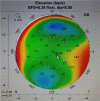New corneal assessment index from the relational thickness and other OCULUS values (CAIRO Index)
- PMID: 30197498
- PMCID: PMC6112792
- DOI: 10.2147/OPTH.S171827
New corneal assessment index from the relational thickness and other OCULUS values (CAIRO Index)
Abstract
Purpose: The aim of this study was to find indices for keratoconus (KC) detection with higher sensitivity and specificity than the currently available ones with the rotating Scheimpflug imaging (Oculyzer I, Pentacam) software.
Patients and methods: Data of 103 normal and 73 KC eyes imaged by Oculyzer I, including slit-lamp examination, refraction, Scheimpflug images, and follow-up data were collected. Logistic regression was done to find new indices with higher area under receiver operating characteristic curves using the currently available ones.
Results: The Corneal Assessment Index from Relational thickness and other OCULUS Values 9 (CAIRO 9) index, deduced from the Ambrosio relational thickness-maximum and the anterior elevation at thinnest point from 9 mm best-fit sphere, and the CAIRO 8, deduced from Ambrosio relational thickness-maximum and anterior elevation at thinnest point from 8 mm best-fit sphere, have a very high area under receiver operating characteristic curves for KC detection (0.997 and 0.995, respectively).
Conclusion: New corneal assessment index is deduced with better sensitivity and specificity for KC detection.
Keywords: elevation; keratoconus; keratoconus diagnosis; keratoconus indices; pachymetry; pentacam.
Conflict of interest statement
Disclosure The authors report no conflicts of interest in this work.
Figures



Similar articles
-
Diagnostic accuracy of different keratoconus detection indices of pentacam in paediatric eyes.Eye (Lond). 2023 Apr;37(6):1130-1138. doi: 10.1038/s41433-022-02070-x. Epub 2022 May 3. Eye (Lond). 2023. PMID: 35505110 Free PMC article.
-
Rotating Scheimpflug Imaging Indices in Different Grades of Keratoconus.J Ophthalmol. 2016;2016:6392472. doi: 10.1155/2016/6392472. Epub 2016 Aug 8. J Ophthalmol. 2016. PMID: 27579178 Free PMC article.
-
[Characteristics of corneal topography in parents of keratoconus patients].Zhonghua Yan Ke Za Zhi. 2020 Jun 11;56(6):456-464. doi: 10.3760/cma.j.cn112142-20191008-00200. Zhonghua Yan Ke Za Zhi. 2020. PMID: 32842328 Chinese.
-
Comparison of multimetric D index with keratometric, pachymetric, and posterior elevation parameters in diagnosing subclinical keratoconus in fellow eyes of asymmetric keratoconus patients.J Cataract Refract Surg. 2015 Mar;41(3):557-65. doi: 10.1016/j.jcrs.2014.05.052. Epub 2015 Feb 21. J Cataract Refract Surg. 2015. PMID: 25708211
-
Parental Corneal Tomographic and Biomechanical Characteristics of Patients With Keratoconus.Am J Ophthalmol. 2023 Dec;256:146-155. doi: 10.1016/j.ajo.2023.08.004. Epub 2023 Aug 10. Am J Ophthalmol. 2023. PMID: 37567431
Cited by
-
Evaluation of parameters for early detection of pediatric keratoconus.BMC Ophthalmol. 2024 Oct 21;24(1):463. doi: 10.1186/s12886-024-03714-0. BMC Ophthalmol. 2024. PMID: 39434060 Free PMC article.
-
Benefits of using corneal topography to choose subjective refraction technique in keratoconus (RE-CON): a prospective comparative crossover clinical study.Graefes Arch Clin Exp Ophthalmol. 2022 Jan;260(1):197-207. doi: 10.1007/s00417-021-05382-y. Epub 2021 Aug 20. Graefes Arch Clin Exp Ophthalmol. 2022. PMID: 34415365
-
Simulation of the Human Myopic Eye Cornea Compensation Based on the Analysis of Aberrometric Data.Vision (Basel). 2023 Mar 12;7(1):21. doi: 10.3390/vision7010021. Vision (Basel). 2023. PMID: 36977301 Free PMC article.
-
Diagnostic accuracy of different keratoconus detection indices of pentacam in paediatric eyes.Eye (Lond). 2023 Apr;37(6):1130-1138. doi: 10.1038/s41433-022-02070-x. Epub 2022 May 3. Eye (Lond). 2023. PMID: 35505110 Free PMC article.
References
-
- Rabinowitz YS, Keratoconus RYS. Keratoconus. Surv Ophthalmol. 1998;42(4):297–319. - PubMed
-
- Belin MW, Zloty P. Accuracy of the PAR corneal topography system with spatial misalignment. Clao J. 1993;19(1):64–68. - PubMed
-
- Committee on Ophthalmic Procedures Assessment Cornea Panel , Cohen EJ(Chair): Corneal Topography Ophthalmology 19991061628–1638. - PubMed
-
- Belin MW, Khachikian SS, Ambrósio R., Jr . Elevation Based Corneal Tomography. 2nd ed. Panama: Jaypee Highlights Medical Publishers; 2012. Understanding Elevation Based Topography: How Elevation Data is Displayed; pp. 25–46. Clayton.
-
- Ramamurthy S, Reddy JC, Jhanji V. Topography and tomography in the diagnosis of corneal ectasia. Expert Rev Ophthalmol. 2015;10(3):215–228.
LinkOut - more resources
Full Text Sources
Other Literature Sources

